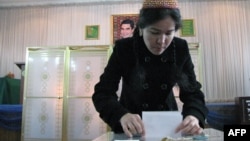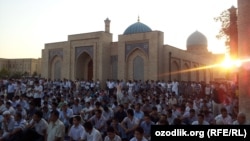
Turkmenistan held elections for local and city councils on November 23.
Not surprisingly, they did not receive much media coverage or generate much interest -- after all, Turkmenistan is a country that had 51 candidates running for 50 seats in the 1994 parliamentary elections. (I always felt kind of sorry for the lone loser in that "race," whatever his or her name was.)
Nothing much has changed in Turkmenistan's political and electoral system in the two decades since then -- aside from some cosmetic changes.
RFE/RL's Turkmen Service, known locally as Azatlyk, spoke with some of Turkmenistan's eligible voters on election day to gauge the level of excitement.
And remember, according to Turkmen election officials, the turnout was 92.76 percent.
A woman in the western Balkan Province said she did not vote.
Asked why she had chosen not to participate in the electoral process, the woman said she had no idea who any of the candidates in her region were. "They have not been out in public. Even in the newspapers, we don't see anything about their plans, their achievements. We don't know them. We don't even know their names," she added.
The woman said she was not the only person in her area who had decided to pass on voting. "There's not much interest. There are entire families who don't go to cast ballots," she said.
But the woman also noted that the entire family did not need to go. Asked if she knew of anyone voting on behalf of an entire family, one of the most prevalent violations in Central Asian elections, the woman replied, "Yes, all the time."
On the other side of Turkmenistan, in the eastern Lebap Province, one man said he did not vote because he was not in his registered district of residence. But he said he had been walking around and passed by some of the polling stations. He said he did not see anyone at the polls until several hours after voting started at 6 a.m. and that over the next few hours he saw only small groups occasionally making their way into polling stations to vote.
The man noted that even the concerts local authorities sponsored outside polling stations did not seem to persuade many people to come and cast ballots.
"They use to give out free food [on election day]," the man said.
OK. Those people were in eastern and western Turkmenistan. Perhaps in the capital, Ashgabat, there was a bit more action?
Sure enough, Azatlyk found a man in Ashgabat who had voted.
Asked what he saw at the polling station, the man replied, "There were some people there [voting], a few." He said one man came and cast votes for himself and "five or six members of his family."
Asked if he knew ahead of time whom he would vote for, the man said he had no idea who any of the candidates were and only learned their names and some information about them from short biographies he received upon arriving at the polling station.
Azatlyk inquired how the man chose whom to vote for, if he did not know any of the candidates.
"I pick the people who have the most humble positions, a teacher or a worker at the local gas distribution plant," he said.
Very proletarian.
One other man from Ashgabat spoke briefly with Azatlyk, saying he had not voted and did not see any reason to do so. He said the whole election process was "staged" and that he, too, had no idea who any of the candidates from his region were.
It's true. Making fun of Turkmenistan's elections is like shooting fish in a barrel. But the November 23 regional and local polls in Turkmenistan are the start of a series of elections in Uzbekistan, Tajikistan, and Kyrgyzstan over the next 13 months.
The Turkmen poll might be an extreme example of a dubious electoral process in Central Asia, but there are sure to be plenty of questionable election practices to observe in neighboring states in the months to come.
-- Bruce Pannier, with contributions from Muhammad Tahir of RFE/RL's Turkmen Service







